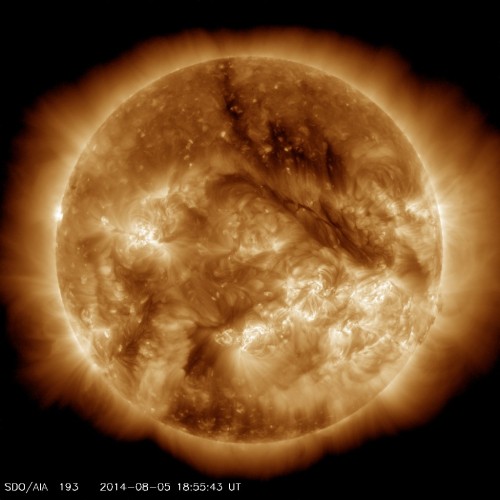
(Photo Credit: NASA/SDO and the AIA, EVE, and HMI science teams)
Scientists have gathered some of the strongest evidence to date to explain what makes the sun’s outer atmosphere so much hotter than its surface.
NASA’s EUNIS (Extreme Ultraviolet Normal Incidence Spectrograph) spacecraft launched in 2013 on a mission to track the properties of a wide range of temperatures in the complex solar atmosphere.
The sun’s visible surface, known as the photosphere, has a temperature ranging between 4,500 – 6,000 Kelvins (4,230 – 5,730 °C). However, the sun’s outer atmosphere, known as the corona, regularly reaches temperatures which are 300 times hotter.
 (The sounding rocket carrying the EUNIS experiment launches from the White Sands Missile Range in New Mexico – Photo Credit: NASA)
(The sounding rocket carrying the EUNIS experiment launches from the White Sands Missile Range in New Mexico – Photo Credit: NASA)
“Things usually get cooler farther away from a hot source. When you’re roasting a marshmallow you move it closer to the fire to cook it, not farther away” says Jeff Brosius, a scientist at NASA’s Goddard Space Flight Centre.
Several theories have been offered to explain how the temperature of the solar atmosphere is so much higher than the sun’s surface, however EUNIS’s very sensitive spectrograph was able to, finally, provide an explanation for the phenomenon.
EUNIS travelled nearly 200 miles above Earth aboard a sounding rocket, a type of NASA mission that flies for only 15 minutes. During flight, the craft intensively observed the sun for around six minutes. Although NASA missions typically spend years gathering data, EUNIS only needed a couple of minutes due to its highly advanced equipment.
 (The EUNIS experiment undergoing tests before launch – Photo Credit: NASA)
(The EUNIS experiment undergoing tests before launch – Photo Credit: NASA)
EUNIS scanned a pre-determined region of the sun that is known to be the site of large flares and coronal mass ejections. As light from the region streamed into the spectrograph, the instrument separated light into its various wavelengths.
This allowed the spectrograph to spot solar material that was around 10 million Kelvins, a temperature that is the signature of nanoflares.
Nanoflares are constant impulsive bursts of heating that could provide an explanation for why the outer solar atmosphere is so much hotter than the photosphere
“This is a real smoking gun for nanoflares,” said Adrian Daw, the current principal investigator for EUNIS at Goddard. “And it shows that these smaller, less expensive sounding rockets can produce truly robust science.”
In addition to having a lower cost, sounding rockets offer a valuable test bed for new technology that may be used on long-duration space missions. Another advantage of sounding rockets is that the instruments parachute back to the ground therefore they can be recovered and re-used.
The EUNIS mission is currently being re-tuned to focus on observing a different set of solar wavelengths. It will fly again sometime after 2016.
You can learn more about nanoflares in the video below:
[Video Credit: NASA/Goddard/Duberstein]